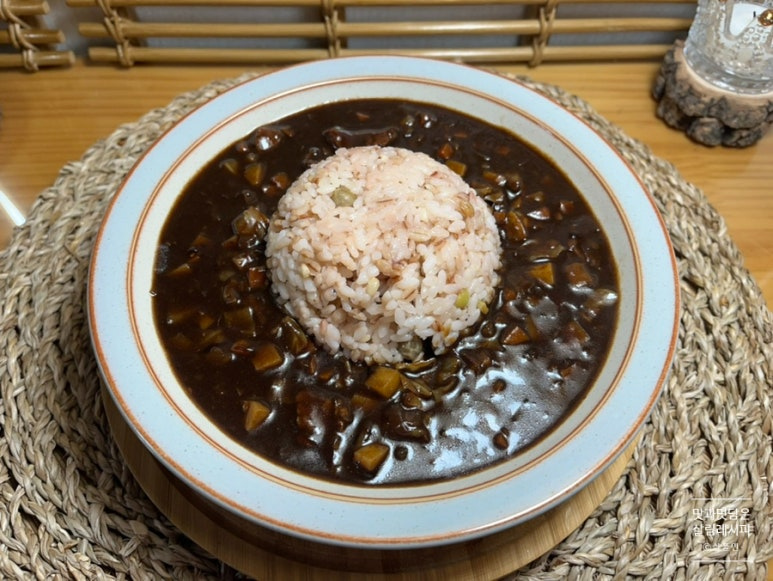Delicious Jjajangbap (Black Bean Sauce Rice Bowl)
Homemade Jjajangbap Recipe Using Instant Black Bean Paste Mix

Introducing a recipe for a satisfying one-bowl meal, Jjajangbap, that rivals the taste of restaurant-style Chinese food, made right in your own kitchen. This dish is a great way to encourage children to eat their vegetables, as you can incorporate various types that they might not usually enjoy. We’ll show you how to easily and simply create a delicious Jjajangbap by adding flavorful seasonings to a store-bought black bean paste mix. Follow along as we guide you step-by-step through making this delightful Jjajang rice bowl.
Main Ingredients- 400g Beef or Pork (lean cut recommended)
- 100g Instant Jjajang Powder Mix
- 700ml Water
- 1 Tbsp Cooking Wine (to remove meat odor)
- 4 Tbsp Cooking Oil (for scallion oil and stir-frying)
- 1/2 stalk Scallion (mostly white parts)
- 1 Onion (medium size)
- 2 Potatoes (medium size)
- 1/2 Carrot (medium size)
- 100g Cabbage
Cooking Instructions
Step 1
First, prepare the meat. You can use either beef or pork, but for this recipe, I’ve prepared lean beef (about 400g). Marinate the meat with 1 tablespoon of cooking wine, gently mixing, and let it sit for about 20 minutes. This helps to remove any gamey odor from the meat.

Step 2
Next, prepare the vegetables that will add richness to your Jjajangbap. You’ll need 2 potatoes, 1 onion, 1/2 carrot, 1/2 scallion stalk, and 100g of cabbage. Feel free to adjust the types and amounts of vegetables based on what you have on hand or your preferences, just as you would for curry. Wash and prepare all the vegetables according to the recipe.

Step 3
The scallions and onions require a special preparation. Finely chop the scallions to make aromatic scallion oil, and finely dice the onions to enhance their sweetness through caramelization when cooked.

Step 4
Heat about 4 tablespoons of cooking oil in a pan over medium-low heat. Add the chopped scallions and stir-fry, being careful not to burn them, until they release a fragrant scallion oil. It’s important to patiently cook the scallions to infuse their aroma into the oil.

Step 5
Once the scallion aroma is released, add the diced onions. Increase the heat slightly (between medium and high) and stir-fry quickly to caramelize the onions, bringing out their natural sweetness.

Step 6
Continue stir-frying the onions with the scallions over medium-high heat until they turn golden brown and develop a sweet fragrance. Properly stir-frying the scallions and onions builds a deeper flavor base for the Jjajang sauce.

Step 7
When the onions are sufficiently stir-fried, add the marinated meat. Cook until about 80% done, breaking it apart with a spatula to prevent clumping.

Step 8
Now, add the firmer vegetables. First, add the potatoes and carrots, and stir-fry with the meat over medium heat for about 3 to 4 minutes. This process helps the vegetables soften slightly and begin to absorb the flavors of the other ingredients.

Step 9
Next, add the cabbage and stir-fry briefly. You can chop the cabbage into larger pieces if you prefer, but if you have picky eaters at home, dicing it finely will help it blend seamlessly into the Jjajang sauce.

Step 10
Once all the ingredients are somewhat stir-fried, pour in 700ml of water. Make sure there’s enough water to cover the ingredients adequately.

Step 11
Now, add the key components for the Jjajang sauce: 100g of instant Jjajang powder mix and 1 Tbsp of sugar. Stir well to prevent lumps and bring to a simmer. Cover the pot, reduce the heat to low, and let it simmer gently for about 10 minutes, stirring occasionally, until the sauce thickens to your desired consistency. This simmering process develops the deep flavor of the Jjajang sauce.

Step 12
Finally, stir in 1 tablespoon of oyster sauce to enhance the savory notes and complete your delicious Jjajang sauce. Serve this rich sauce generously over warm rice for a Jjajangbap that rivals restaurant quality. For an even more decadent touch, top with a fried egg. Using instant Jjajang powder makes this recipe virtually foolproof, and with just a few extra seasonings, you can achieve a truly gourmet taste. Consider pairing this Jjajangbap with air-fried sweet and sour pork for a hearty and healthy meal that evokes the flavors of your favorite Chinese restaurant. We hope this simple yet delicious Jjajangbap recipe brings you a wonderful home-cooked meal experience!



